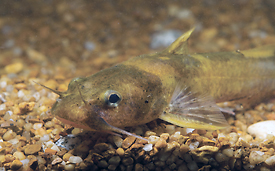Name all the venomous animals you can think of and you probably come up with snakes, spiders, bees, wasps and perhaps poisonous frogs. But catfish?
A new study by graduate student Jeremy Wright finds that at least 1,250 and possibly more than 1,600 species of catfish may be venomous, far more than previously believed.

Lest anyone have concerns about attacks of killer catfish, rest assured that, at least in North America, these finned fatales use their venom mainly to defend themselves against predatory fish, though they can inflict a painful sting that many fishermen have suffered. In other parts of the world, some catfish do have extremely toxic venoms that can be deadly to humans.
Scientists have focused a great deal of attention of venom produced by snakes and spiders, but venomous fish had been largely neglected, says Wright, who used histological and toxicological techniques, as well as previous studies of evolutionary relationships among catfish species, to catalog the presence of venom glands and investigate their biological effects.
Catfish venom glands are found alongside sharp, bony spines on the edges of the dorsal and pectoral fins, and these spines can be locked into place when the catfish is threatened. When a spine jabs a potential predator, the membrane surrounding the venom gland cells is torn, releasing venom into the wound. In his paper, Wright describes how catfish venoms poison nerves and break down red blood cells, producing such effects as severe pain, reduced blood flow, muscle spasms and respiratory distress. However, because none of the species he examined produces more than three distinct toxins in its venom, each species probably displays only a subset of the whole repertoire of effects.
The main dangers to humans who tangle with North American catfish come not from the initial sting and inflammation, but from secondary bacterial and fungal infections that can be introduced through the puncture wound or when pieces of the spine and other tissue break off in the wound, Wright says.
On the evolutionary side, Wright’s analyses point to at least two independent origins of catfish venom glands. In addition, the toxic proteins show strong similarities with, and might be derived from, previously characterized toxins found in catfish skin secretions.
Further examination of the chemical composition of the venoms also will provide valuable insight into the mechanisms and potential selective factors driving venom evolution in fishes, Wright says.
The research is described in a paper published online in December in the open access journal BMC Evolutionary Biology.

